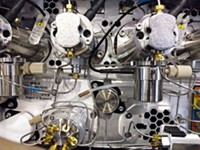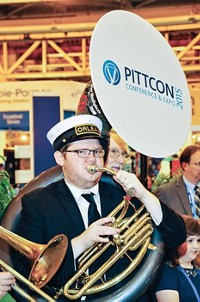Advertisement
Grab your lab coat. Let's get started
Welcome!
Welcome!
Create an account below to get 6 C&EN articles per month, receive newsletters and more - all free.
It seems this is your first time logging in online. Please enter the following information to continue.
As an ACS member you automatically get access to this site. All we need is few more details to create your reading experience.
Not you? Sign in with a different account.
Not you? Sign in with a different account.
ERROR 1
ERROR 1
ERROR 2
ERROR 2
ERROR 2
ERROR 2
ERROR 2
Password and Confirm password must match.
If you have an ACS member number, please enter it here so we can link this account to your membership. (optional)
ERROR 2
ACS values your privacy. By submitting your information, you are gaining access to C&EN and subscribing to our weekly newsletter. We use the information you provide to make your reading experience better, and we will never sell your data to third party members.
Analytical Chemistry
Guarded Optimism For Instruments
Despite headwinds, scientific instrumentation executives expect an uptick in sales this year
by Marc S. Reisch
April 15, 2013
| A version of this story appeared in
Volume 91, Issue 15
To judge solely by the number of attendees, interest in the latest scientific instruments and analytical methods was high at the Pittsburgh Conference on Analytical Chemistry & Applied Spectroscopy, Pittcon 2013, held in Philadelphia. Yet instrument makers were only guardedly optimistic about their businesses because of government spending constraints and slow economic growth in industrialized countries.
COVER STORY
Guarded Optimism For Instruments
More than 18,000 people attended this year’s event, up from 15,754 at last year’s meeting held in Orlando. According to the Pittcon 2013 Organizing Committee, 40% of visitors attended the conference for the first time. Both the exhibition hall, where more than 1,000 companies showcased their products, and conference rooms seemed busier this year. The bone-chilling wet weather encouraged more people to stay indoors at the meeting and spend less time visiting the local sights.
Two companies were notable no-shows: Agilent Technologies and PerkinElmer, both among the top 10 instrument makers. It’s the second year in a row that both these companies have skipped Pittcon, and the two have said they preferred to meet one-on-one with customers. Some of their bigger competitors, such as Waters Corp. and Shimadzu, made a point of saying they appreciated the chance to meet customers at the show without the additional competition.
Instrument makers who did make it to this year’s event said they hoped the high attendance would translate into a good year for sales, but they were cautious. “Last year was not as good as many of us hoped,” Rohit Khanna, vice president of worldwide marketing for chromatography instrument maker Waters, told C&EN. “We’re seeing some level of buyer interest coming back this year,” he said. “But people don’t have the money” to spend.
Still, researchers will find the money for new technology that offers greater analytical speed and precision, Khanna predicted. One such instrument he thought polymer chemists will decide they cannot do without is the Acquity Advanced Polymer Chromatography System introduced at Pittcon 2013 (see page 34). The instrument characterizes low-molecular-weight polymers more accurately and is up to 20 times faster than traditional gel-permeation chromatographs, which it updates.
Dow Chemical initiated development of the Acquity APC System in 2010 and called on Waters to help it expand upon and commercialize the system, said James N. Alexander, associate analytical R&D director at Dow. The partnership recalls Waters’ original development of gel-permeation technology with Dow in the early 1960s.
“Dow was smart enough to figure the more they knew about polymers, the better the quality of materials they could make,” said Waters founder James L. Waters, 88, who was at Pittcon. That first deal with Dow helped make the instrument maker a force to reckon with in the chromatography market, he said.
Other instrument makers also used Pittcon to showcase new equipment. For example, Thermo Fisher Scientific, one of the largest instrument firms, displayed a new electrochemical detector, the Dionex UltiMate 3000 (see page 34). The instrument is capable of measuring pharmaceuticals and other complex samples. It also introduced its new Chromeleon version 7.2 software to integrate lab instrumentation.
But Thermo Fisher executives said they are concerned about the impact of slow growth in industrial countries and the effect on government-backed researchers of the two-month-old U.S. sequestration of federal funds. If sequestration goes on through the end of the year, it could have a half-percent negative impact on sales, said Marc N. Casper, Thermo Fisher’s chief executive officer. Thermo Fisher had sales in 2012 of $12.5 billion and is otherwise expecting to see sales grow between 2 and 4% in 2013.
“We see a lot of insecurity among researchers who are entrusted with making buying decisions,” said Rainer Blair, president of the AB Sciex unit of holding firm Danaher Corp. Blair characterized Europe and North America as particularly choppy markets for AB Sciex, whose mass spectrometry instruments are used in health care, food, and environmental research.
Frank H. Laukien, CEO of Bruker, complained the sequester was one reason that U.S. customers have yet to adopt the firm’s latest dynamic nuclear polarization/nuclear magnetic resonance spectrometer. Developed with Massachusetts Institute of Technology, the latest 527-GHz instrument has been installed at Utrecht University, in the Netherlands, where scientists will use it to study complex biomolecules.
China, however, remains a strong market, said Blair, because of the government’s new five-year plan to improve the nation’s health care system.
China figured into other firms’ growth plans too. Chris McIntire, president of Xylem Analytics, said his company will benefit from China’s plan to purchase instrumentation so it can more closely monitor the quality of water in the country’s rivers and streams.
In these challenging economic times, smaller instrument makers also hope to make inroads in the market, many with significantly smaller instruments than those made by bigger competitors. For instance, Senova Systems launched the solid-state $1,650 pen-sized pHit Scanner pH meter (see page 31). Founder Lee Leonard claims the pHit Scanner will replace traditional glass electrode sensors and make significant inroads into the $1 billion pH testing market.
Microsaic Systems launched a new semiconductor-based mass spectrometer, the 4000 MiD (see page 31), which can fit under a standard fume hood and requires a fraction of the power of standard mass spectrometers. And start-up firm Analytical Pixels Technology launched semiconductor-based gas chromatographs (see page 31) for lab, industrial, and petrochemical applications, including process monitoring and energy distribution.
Whether the smaller instrument makers will succeed in the current tight market is unclear. What is certain is that researchers are being careful about what they buy. “It is not that funds are drying up,” said AB Sciex’ Blair. “But people are not sure what the future holds because of the macroeconomic environment.”





Join the conversation
Contact the reporter
Submit a Letter to the Editor for publication
Engage with us on Twitter